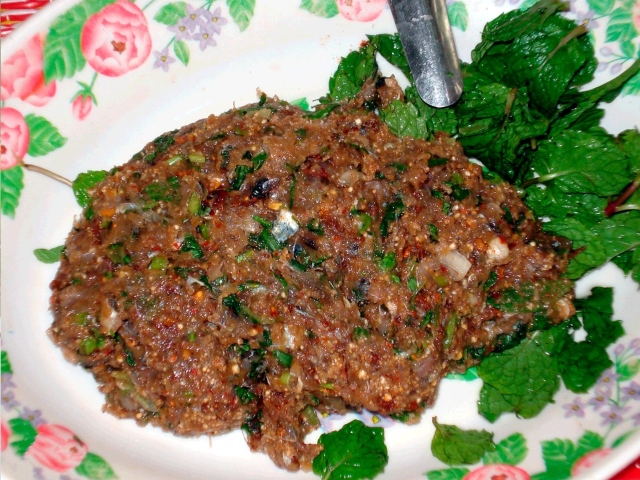
-
A Single Bite Of This Meal Can Give You Liver Cancer
12 Sep 2023 by Heinrich in Tech/Sci, World
[imagesource:wikicommons]
Don’t worry, it’s got nothing to do with the gourmet vetkoek Woolies are now selling, but rather a much-loved Thai delicacy that contains raw fish.
The dish is something known as koi pla, a cheap meal made by mincing raw fish with herbs, spices, and lemon juice, and is particularly popular in one of Thailand’s poorest regions, Isaan.
Eaten by millions of people, the dish is also known to have a deadly side effect: It can cause those who eat it to develop fatal liver cancer.
It is not actually the fish that are the cause, but rather the liver flukes – parasitic flatworms – that often live inside them. These flukes are so prevalent and the dish so popular that the level of liver cancer in Isaan province is bizarrely high. In fact, it is thought that the disease accounts for more than 50 percent of cancers diagnosed in men in this region, compared to just 10 percent globally.
One of the leading researchers into this is Narong Khuntikeo, who trained to be a liver surgeon in this region after losing both his parents to cancer.
Khuntikeo is now on a mission to educate people as to the danger that koi pla poses. He has been organising a group of doctors, scientists, and researchers to take ultrasound machines and urine tests around Isaan to test villagers for the disease.
The fish used to make the dish are caught in Mekong, where the liver fluke is widespread. Since the fish is eaten raw, it means that over time locals build up a high parasite load that can then lead to the development of liver cancer. In his mission to teach people about the threat of the fluke, Narong has encountered many people who have been eating the local dish since they were young, but who have never been tested.
It has not, however, been easy to persuade people to take the tests. The dish, despite its clandestine danger, is a delicacy in the region and people have been eating it for decades.
“Nobody knows about this because they die quietly, like leaves falling from a tree.”
The locals, particularly the older folk, are resistant to change and feel that cooking the fish, which is the best way to kill the parasite, ruins the taste.
Khuntikeo’s team has spent four years driving ultrasound machines and urine testing kits around the Isaan region, screening villagers for the parasite. Up to 80% of the inhabitants of some communities were found to have ingested the parasite. At a recent testing, a third of villagers showed abnormal liver symptoms and four were suspected to have cancer.
Local health officials have now also introduced a school curriculum of colourful cartoons that aims to teach children about the risks of raw foods. But older generations are harder to convince, says Khuntikeo.
“They’ll say: ‘Oh well, there are many ways to die,’” he said. “But I cannot accept this answer.”
[source:guardian]
Latest News
-
Game, Seth, Match – Goodbye 2024
Hey Guys - thought I’d just give a quick reach-around and say a big thank you to our rea...
-
Breakfast Of Champions: Hollywoodbets Kenilworth Racecourse Breakfast Gallops Is Back!
[imagesource:CapeRacing] For a unique breakfast experience combining the thrill of hors...
-
Need NYE Plans? Cafe Caprice’s Night Of Enchantment Masquerade Party Could Do The Trick
[imagesource:howler] If you're still stumped about what to do to ring in the new year -...
-
Buckingham Palace Steps In After Staff Christmas Party Spirals Out Of Control
[imagesource:maxandeli/facebook] It's not just in corporate that staff parties get a li...
-
Designer Babies Are Running Into Trouble As Teens, Grappling With Being ‘Experiments’
[imagesource:here] Imagine being born with the weight of your parents’ version of per...
-






























